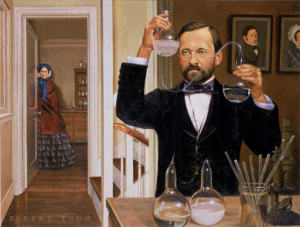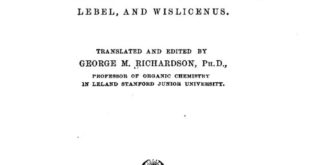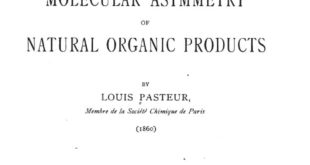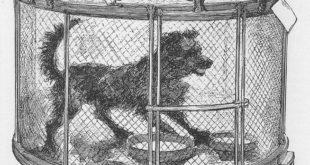Originally published by Louis Pasteur in 1880

I would like to reiterate the following results, which I have previously had the honor of presenting to the academy:
- Fowl cholera is a virulent disease of the first order.
- The virus* consists of a microscopic parasite which multiplies readily in culture away from the animal body. From this it is possible to obtain the virus in a state of purity and demonstrate irrefutably that it is the sole cause of the disease and death.
- The virus may vary in its virulence. At times the disease is followed by death, while at other times, after causing disease symptoms of variable intensity, recovery occurs.
- These differences in the virulence of the virus are not merely the result of natural variations, as the experimenter can alter them at his will.
- As is generally the case for all virulent diseases, fowl cholera does not recur, or rather the recurrence is of such a degree that it is inverse in intensity with that of the earlier infection, and it is always possible to extend the resistance so far that inoculation with the most virulent virus does not produce any effect.
- Without wishing to make a definite assertion on the relationship between the small pox and the cow pox viruses, it seems from the above facts that in fowl cholera, there exists a state of the virus relative to the most virulent virus, which acts in the same way as cow pox virus does in relation to small pox virus. Cow pox virus brings bout a benign illness, cow pox, which immunizes against a very serious illness, small pox. In the same way, the fowl cholera virus can occur in a state of virulence that is sufficiently attenuated, so that it induces the disease but does not bring about death, and in such a way that after recovery, the animal can undergo an inoculation with the most virulent virus. Nevertheless, the difference between small pox and fowl cholera is considerable, in certain respects, and it is not amiss to remark that, with respect to an understanding of the principles, studies on fowl cholera will probably be more helpful. Whereas there is still a dispute about the relationships between small pox and cow pox, we know for certain that the attenuated virus of fowl cholera is derived directly from the most virulent virus of this disease, so that their natures are fundamentally the same.
I will now demonstrate the truth of this main assertion, which is at the base of the preceding proposition, namely, that there are variable states in the virulence of the virus of fowl cholera. This result may seem strange when one thinks that the virus of this diseases is a microscopic organism which can be handled in a state of perfect purity, in the same way as the yeast of beer or the mycoderma of vinegar. And further, if one considers this strange fact of variation in virulence clearly, one cannot keep from recognizing that this phenomenon is probably common to diverse species of organisms causing infectious diseases. But where is the common factor in these various infectious diseases? In order to cite only one example, is it no usually considered that the variations in the severity of epidemics of variola, sometimes serious, while at other time benign, are due to differences in environmental conditions, to the climate, or to the resistance of the individuals? Is it not equally seen that major epidemics gradually die out and then reappear and die out again?
The idea of the existence of variable degrees of virulence of the same virus is not made in order to surprise the physician or laymen, but because it may be of tremendous importance if it could be established scientifically. In the present case, the mystery is certainly connected with the fact that the virus, being a microscopic parasite, reveals variation in its virulence that are at the control of the observer. It is this point which I would like to establish rigorously.
Let us begin with a virus of fowl cholera which is in the most virulent state possible. Previously I developed a curious method for obtaining a virus with this virulence. This was done by collecting the virus from a chicken which was about to die, not from an acute but from a chronic infection. I have observed that the cholera exists occasionally in this latter form. These cases are rare, but a number of these were obtained. IN these cases, the chicken, after becoming very sick, grows more and more emaciated but does not die for weeks or months. When death occurs, it is because the parasite, up until this time localized in certain organs, passes into the blood and reproduces there. One can then observe that the virulence of the virus cultured from the blood of an animal which has taken a long time to die is considerably higher than the virulence of the virus which was used to inoculate this animal, so that it is able to kill all animals that are injected with it.
Let us now make successive cultures of this virus, always in a state of purity, in a medium of chicken broth, by taking the inoculum for each culture from the preceding culture, and then testing each culture for its virulence. This observation shows that the virulence does not change significantly from one culture to the next. In other words, if we admit that two virulences are identical, when upon injecting the same number of animals under the same conditions , and the same proportion which die in the same length of time is the same, then we have established that the virulence of our successive cultures is identical.
I made no statement above about the length of time between one culture and the next, or the possible influence of this duration upon the virulence of successive cultures. Let us now turn our attention to this point, and consider the smallest interval which appears to bring about changes. An interval from one to eight days between cultures does not effect the virulence of the successive cultures. An interval of 15 days shows the same results. After an interval of one month, six weeks, or two months, one does not observe any more change. Nevertheless, as the interval is increased, it is possible to perceive at times certain signs of a decrease in virulence, like a weakening of the inoculating virus. For example, the rapidity of death seems to diminish, although the proportion of deaths does not. IN various series of inoculated animals, one sees chickens which languish, are very sick, often become very lame because the parasite, in its progression, has passed into the muscles and has attacked those of the legs. The pericardium may become elongated; abscesses appear around the eyes; and finally the virus has lost is fulminating character. Let us then go to longer intervals than these, before we transfer the culture again. Intervals of three, four, five, eight months, or more can be used, before the virus is again tested for virulence. Each time the picture is changed considerably. Differences in virulence are found which are considerable, while previously the changes were either insignificant or were only revealed in a very equivocal manner.
When such intervals between culturing are used, one finds that instead of identical virulence, the virulence, is decreased, so that out of ten chickens inoculated, only nine, eight, seven, six, five, four, three, two, or one out of ten die, and at times not a one dies, so that the sickness may develop in all of the inoculated chickens, but they all recover. In other words, by a simple change in the way in which the parasite is cultured, merely by lengthening the time between transfers, we have obtained a method for decreasing progressively the virulence of the virus, until finally we have a virus which is a true vaccine, in that it does not kill, but induces a benign illness which immunizes against a fatal illness.
It would not be expected that in all attempts at attenuation, the procedure would occur with a reproducible and mathematical regularity. Some cultures which have not been transferred in five or six months show a considerable virulence, while others of the same origin may already be quite attenuated after three or four months. We will later explain this anomaly, which is only apparent rather than real. Often there is a steep jump from a good virulence down to a state in which the microscopic parasite has died, and this may take place in a very short interval. In passing it from one culture to the next, one is surprised by the absence of growth of the culture. The death of the parasite is furthermore a usual thing if one allows the culture to stand a sufficient length of time….
In the course of these changes, what happens to the microscopic organism? Does it change its form or appearance while changing its virulence in such a profound way? I would not like to insist that there does not exist a certain relationship between the morphology of the parasite and its virulence, but I must admit that such a relationship is almost impossible to perceive, and if it exists, it is missed even when using the microscope, because of the very small size of the virus. Cultures of all degrees of virulence seem similar. If it seems at times that small changes have occurred, it may only be accidental, and in later observations these changes may disappear or appear in an inverse relationship to earlier changes.
It is possible to say that if one takes a number of cultures of varying virulences, and starts new cultures with them and continues to make successive transfers at the same time interval for all of the cultures, the virulence of each culture is maintained at the same level as it originally was. For example, an attenuated virus which only kills once out of ten inoculations maintains this virulence in successive cultures, if the interval of transfer is not too long. Although probably in line with the preceding observations, it is equally interesting that an interval between transfers which is sufficient to bring about the death of an attenuated virus may not necessarily bring about the death of a highly virulent virus, although it serves to attenuate it.
We must now consider the important question of what is the cause of the decrease of virulence.
The cultures of the parasite are necessarily kept in contact with air, because the virus is an aerobic organism and cannot develop when kept in the absence of air. It is therefore natural to ask initially if it would not be in the contact with air that the attenuation influence exists. Would it not be possible that the tiny organism which is the virus, while developing in the presence of oxygen in the culture medium undergoes several modifications which become permanent, and still remain when the organism is removed from the influence of the oxygen? It is also possible to ask if there might not be some other principle in the atmosphere, chemical or fluid, which might intervene in the accomplishment of this phenomenon.
Our first hypothesis that it is oxygen in the air which brings about the change can easily be put to experimental test. This can be done by observing whether the phenomenon is suppressed in the absence of oxygen.
To this end the following experiment was performed. A convenient quantity of chicken broth was seeded with the most virulent virus we have, and glass tubes were filled with this seeded broth to two-thirds, of their volume, three-fourths, and so on, and then the tubes were closed under a flame. With the small amount of air remaining in the tubes, the virus began to grow, and this could be determined by observing the turbidity of the tube develop. During the growth in the tube, gradually all of the oxygen in the tube was used up. Then the turbidity fell to the bottom and the virus was deposited on the walls of the tube and the liquid became clear. It took two or three days for this to occur. The tiny organisms are thereafter without oxygen and they will remain in this state for as long as the tube is not opened. What has happened to their virulence? In order to avoid mistakes in this study, we prepared a large number of parallel tubes, and at the same time an equal number of flasks of the same culture, but freely exposed to contact with the air. We have already stated what will happen to culture that are exposed to air. They become progressively less virulent. This phenomenon was found again in this experiment in the cultures exposed to the air. Let us speak only of those cultures in the closed tubes, cultures without contact with the air. Let us open tubes at various intervals, one month, two months, three months, four months, and son, and transfer them into new broth tubes and then test their virulence….Remarkably, the experiment shows that the virulence under these conditions is always the same as that which was used to inoculate the original closed tubes. Meanwhile the cultures which have been exposed to air are either dead or possess a very weak virulence.
Our problem is therefore solved: it is the oxygen which brings about the attenuation in virulence.
Truly, there is more here than an isolated fact. We are in possession of a general principle. One may hope that there may be an action inherent in atmospheric oxygen, a natural force always present, which will enable us to perform similar attenuations on other viruses. In any case, we have here a circumstance worthy of interest for the possible large generality regarding a method for the attenuation of virulence, which may derive from some influence of the cosmic order of things. May we not assume here that it is perhaps this influence which is responsible, in the present as in the past, for the eventual limitation of the large epidemics?…
 Pasteur Brewing Louis Pasteur – Science, Health, and Brewing
Pasteur Brewing Louis Pasteur – Science, Health, and Brewing 


